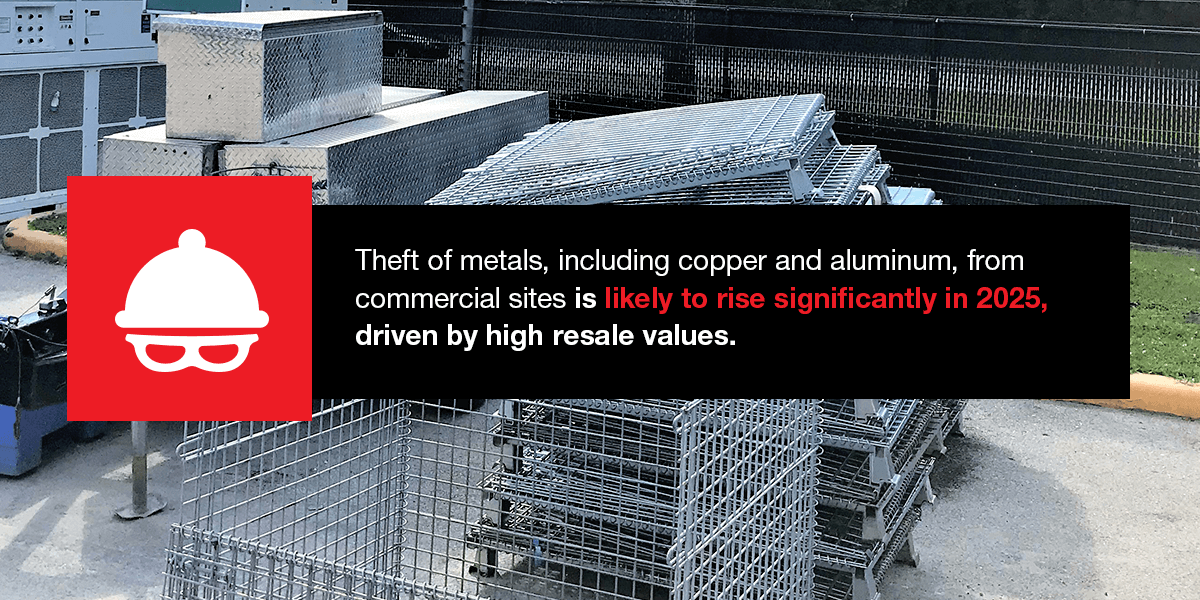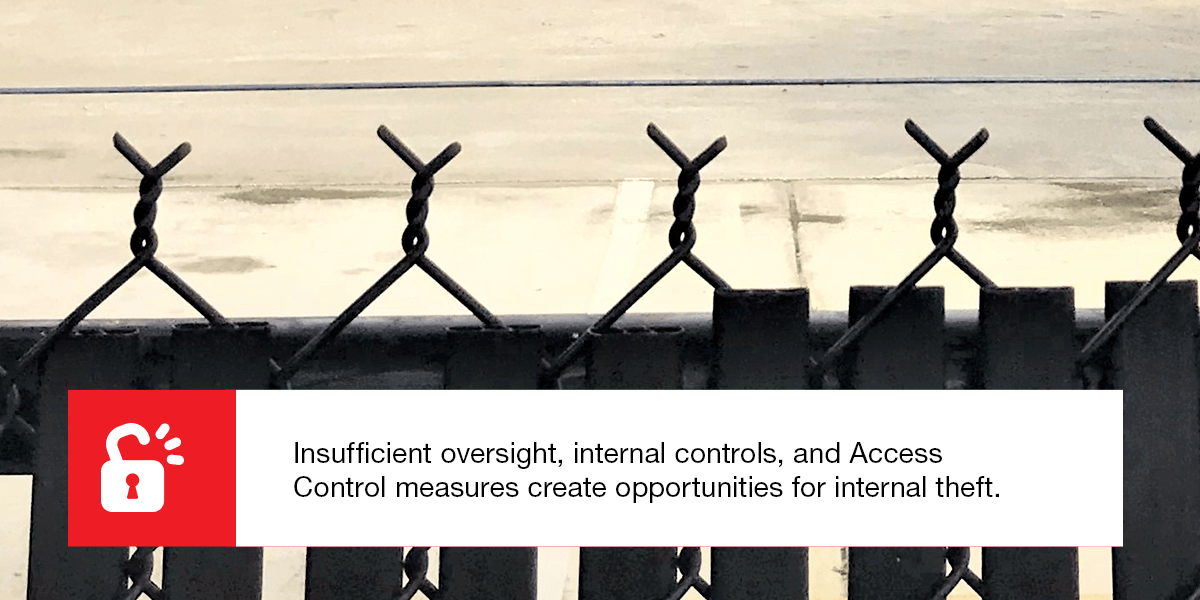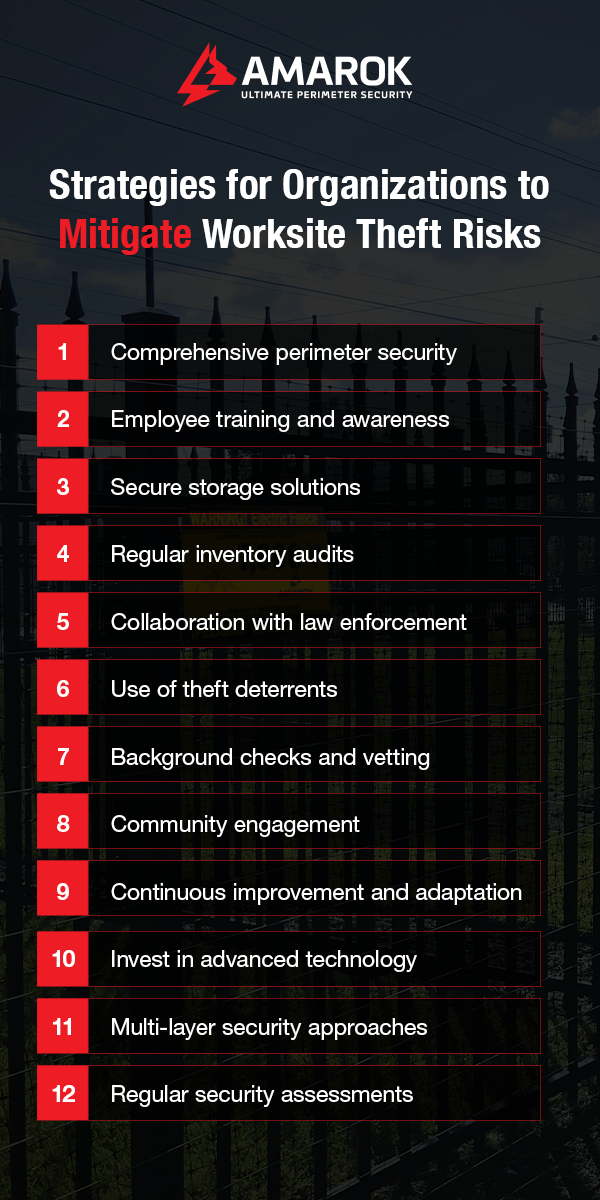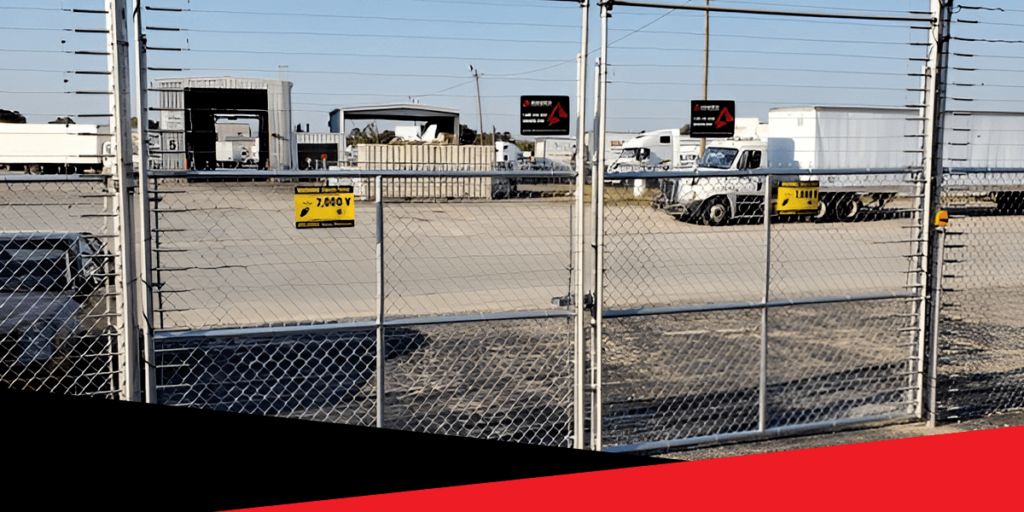As crime evolves, companies must implement comprehensive security measures to protect assets. Experiencing theft of products or equipment can lead to significant financial losses and damage a business’s reputation in its industry. Traditional security measures may no longer be enough to deter determined thieves, especially in vulnerable locations.
The anticipated business theft and security trends for 2025 suggest several changes and developments that businesses must prepare for. These trends highlight the importance of staying informed about theft risks and investing in security solutions. This article discusses theft statistics, the impact of crime on businesses, and implications for specific sectors.
Anticipated Theft Trends for 2025
Businesses across various industries are expected to face a complex landscape of theft and security challenges. These are the anticipated trends from evolving criminal tactics:
Metal theft
Theft of metals, including copper and aluminum, from commercial sites is likely to rise significantly in 2025, driven by high resale values. Construction sites, power plants, and telecommunications facilities are prime targets.
Property damage
Commercial properties will remain at risk of vandalism, arson, and property damage. These acts of vandalism are often influenced by socioeconomic factors, social unrest, and substance abuse. This damage results in financial losses and affects the sense of security for businesses and employees.
Burglary and break-ins
In the U.S., the larceny-theft rate has increased since 2021. The occurrence of traditional property crimes, including burglaries, will persist, particularly on properties with valuable inventory. Repeat offenders familiar with security systems pose a significant challenge, which means businesses require enhanced security measures.
Employee theft
Internal theft will continue to be a major concern, as employees may exploit their access to merchandise and information.
Cargo theft
The logistics sector will continue to face ongoing threats from cargo theft, especially as more criminals hone their techniques. Thieves often target valuable shipments like electronics and pharmaceuticals. The rise of organized crime networks further complicates recovery and prevention efforts.
Construction site theft
Construction sites will remain vulnerable due to the high value of unattended equipment and materials. The insufficient security measures at most construction sites are likely to result in ongoing theft, causing project delays and increased costs.
Equipment and vehicle theft
Thieves will increasingly target construction, landscaping, and trucking industries for valuable equipment and vehicles. Advances in technology have made it easier for criminals to bypass many traditional security measures.
Organized theft rings
Organized crime will play a larger role in theft, with sophisticated groups targeting high-value items. These rings often operate across regions, making them difficult to apprehend and disrupt.
Supply chain vulnerabilities
The supply chain will remain a weak point, with ongoing threats from both individuals and organized gangs targeting shipments.

The Causes of These Theft Trends
The anticipated theft and security trends are attributed to a variety of interconnected causes. Knowing about the causes of these occurrences will help businesses develop risk mitigation strategies and enhance security.
Here are some of the factors driving these trends:
- Economic pressures: Inflation and increased living costs add to financial strain on individuals and businesses, and economic downturns often result in layoffs. This economic strain may lead some individuals to resort to theft.
- Increased value of assets: The demand for metals and high-value items drives theft as criminals seek to capitalize on their resale value. Shortages in certain materials and equipment also create a lucrative market for thieves targeting these items.
- Advancements in technology: Criminals are using technology to bypass traditional security methods. This includes the use of sophisticated hacking tools to breach security systems and steal vehicles and cargo.
- Access to information: The Internet and social media make it easier for criminals to share information about vulnerabilities and successful theft techniques.
- Strained law enforcement resources: With rising violent crime rates, law enforcement agencies sometimes prioritize resources toward addressing these issues. As a result of the lower focus on property crimes, overwhelmed local law enforcement personnel face challenges responding effectively to theft incidents.
- Social unrest: Economic inequality, social unrest, and community dissatisfaction may lead to individuals expressing their frustrations through vandalism and property damage.
- Substance abuse: Higher rates of substance abuse correlate with increased property crimes, as individuals may resort to theft to fund their habits.
- Changes in crime dynamics: Criminals adapt to changing security measures. They tend to target less secure locations or assets that are easier to reach.
- Lack of oversight: Insufficient oversight, internal controls, and Access Control measures create opportunities for internal theft, as employees may see an opportunity to commit crime without fear of detection.
- Complex supply chains: The growth of e-commerce has resulted in more goods being shipped and delivered. As supply chains become more complex, there are more points of vulnerability, which means more opportunities for thieves to exploit gaps in security.

Industry-Specific Property Crime Trends
The range of escalating property crime trends necessitates enhanced critical infrastructure and multi-layer security measures. Here’s an overview of how theft trends can affect different sectors and how they should respond.
Airport parking
Enhanced surveillance and secure payment systems should be implemented to protect vehicles and belongings in airport parking lots.
Auto auctions
The theft of vehicles before auctions will rise. These companies will need to adopt vehicle tracking and strict Access Control measures to secure their lots.
Auto dismantling
Dismantlers will need to implement comprehensive surveillance systems and inventory control measures due to the increased theft of auto parts.
Auto rentals
Theft rates of rental vehicles will rise, demanding the implementation of stricter security protocols. Remote immobilization technology will help stop theft and track stolen vehicles.
Building supply
The demand for building materials will drive theft at these facilities. These companies will need to enhance site security with perimeter fencing and advanced inventory management systems to minimize theft.
Cannabis
The high value of cannabis products will lead to increased targeting of growing facilities. It’s important to implement strict security measures and inventory tracking systems to prevent theft.
Collision centers
The rising theft of vehicles undergoing repairs will require secure storage areas and enhanced monitoring systems to protect valuable cars.
Construction sites
Continued theft of tools and materials will plague job sites. Construction companies will need to hire security personnel and implement temporary fencing with lighting to deter nighttime theft.
Critical infrastructure
Potential terrorist threats will result in advanced surveillance technologies and stricter Access Control measures for sensitive areas.
Data centers
Data centers must implement physical security measures and conduct regular security audits to identify vulnerabilities.
Distribution
Countering cargo theft during transit demands enhanced security checks and advanced surveillance technology to monitor loading docks and storage areas.
Equipment rental
Businesses are adopting radio frequency identification (RFID) technology and investing in secure rental facilities to mitigate the increased risk of equipment theft.
Landscaping
Landscaping companies must contend with the potential theft of expensive tools and equipment left unattended at job sites. Mobile surveillance units and secure storage solutions will become essential for safeguarding these assets.
Metal recycling
Rising metal prices will fuel theft from construction sites and businesses. Enhanced scrutiny of transactions and installation of surveillance systems will be critical to monitor activity.
Self-storage
More theft incidents from self-storage units will drive stricter verification procedures and Access Control to enhance security.
Truck sales and service
The risk of vehicle and parts theft from sales lots will drive investment in enhanced security measures. This could include fencing and surveillance cameras.
Trucking
The theft of high-value cargo is expected to rise due to economic pressures. Some businesses will increasingly rely on GPS tracking and secure parking or storage facilities with surveillance to protect assets.
Vehicle fleet
With increased theft targeting fleet vehicles, operations will need to adopt more fleet management solutions. These may include secure parking facilities and GPS tracking.
Emerging Security Solutions for 2025
While business theft is expected to change and grow, so will security capabilities. These trends focus on integrating advanced security technology, including artificial intelligence (AI) and risk management. Here’s an overview of security solution trends:
- Risk management: Businesses will prioritize managing and mitigating risks by integrating security, IT, and human resources (HR). This approach emphasizes the role of risk analysts within security teams to predict threats and vulnerabilities.
- Virtual security operations centers (VSOCs): Traditional global security operations centers (GSOCs) are evolving into VSOCs, enabling remote monitoring of security systems, including camera feeds. The transition allows businesses of all sizes to enhance their security reach and responsiveness.
- Autonomous security technology: Security organizations will make more use of drones to address labor shortages and fill gaps. Drones can handle routine surveillance tasks while security personnel focus on decision-making and problem-solving.
- Access Control: Access Control systems are shifting from traditional badge systems to more versatile solutions, including biometric authentication and mobile devices. This move enhances security while improving user convenience.
- Consolidated security technology: Businesses will streamline their security technology by integrating multiple functions into single tools, reducing complexity and enhancing efficiency in managing security operations.
- Advanced surveillance solutions: AI-driven video surveillance systems will gain prominence. Facilities can use machine learning to detect unusual behaviors and alert security teams in real time, improving threat detection and response times.
- Cloud-based security solutions: Cloud technology offers flexibility and scalability, allowing organizations to monitor and control their security systems remotely. Cloud-based solutions enable data management and improve response capabilities.
- Integrate cyber-physical security: As organizations recognize the need for a holistic security approach, converging physical and cybersecurity will become crucial. Integrating these two domains strengthens defenses against both physical and digital threats.
- Sustainability initiatives: As environmental concerns grow, more security solutions will focus on sustainability. This focus is manifesting in measures such as incorporating energy-efficient technologies like solar-powered cameras.
- Personalized security solutions: There will be a shift toward tailored security solutions that meet the specific needs of various businesses. Since different industries have their own security challenges, companies will move away from one-size-fits-all approaches.
A key takeaway from these trends is the increasing importance of integrating physical security solutions with digital technologies. Embracing these emerging security trends will be essential for businesses to maintain security and operational efficiency in the face of modern theft challenges.
Strategies for Organizations to Mitigate Worksite Theft Risks
To effectively combat theft risks at your facility and safeguard assets, you should adopt a comprehensive, multifaceted approach to security. Here are our key strategies to mitigate worksite theft risks:
1. Comprehensive perimeter security
Develop tailored security protocols that include perimeter fencing, Access Control systems, surveillance cameras, adequate lighting, and clear signage. This clear indication that the property is protected will help deter unauthorized access and theft.
2. Employee training and awareness
Implement regular training programs to educate employees about theft prevention, security protocols, and how to remain vigilant. Train staff to recognize suspicious activities and report breaches promptly.
3. Secure storage solutions
Store valuable equipment and materials in secure facilities with robust locking mechanisms. Use inventory management systems to track assets and restrict access to authorized personnel only.
4. Regular inventory audits
Conduct frequent inventory audits to verify the expected numbers of equipment and materials on-site. Compare physical counts with inventory records to identify discrepancies and prevent unauthorized removal.
5. Collaboration with law enforcement
Establish strong relationships with local law enforcement agencies and neighborhood security companies to enhance theft prevention efforts. Create communication channels for reporting incidents and coordinating responses.
6. Use of theft deterrents
Deploy alarm systems, security patrols, and GPS tracking devices on high-value assets to enhance recovery capabilities in the event of theft.
7. Background checks and vetting
Implement thorough background checks for employees, subcontractors, and vendors to mitigate insider threats and ensure only trusted individuals have access to the worksite.
8. Community engagement
Foster relationships with local communities and establish neighborhood watch programs to enlist support in monitoring facilities and reporting suspicious activities.
9. Continuous improvement and adaptation
Maintain a proactive approach to theft prevention. Regularly update security measures in response to emerging threats and adopt new technologies as they become available.
10. Invest in advanced technology
Use AI-powered surveillance systems, cloud-based security solutions, and smart Access Control technologies to enhance monitoring and response capabilities.
11. Multi-layer security approaches
Focus on combining physical, digital, and procedural security measures for comprehensive coverage. Doing so will create a comprehensive defense system and ensure protection against physical threats for greater peace of mind.
12. Regular security assessments
Because local trends and crime patterns can vary widely, new theft trends are always emerging. Perform ongoing security assessments to identify vulnerabilities and evaluate the effectiveness of current measures. Engage external security experts to conduct site surveys and threat assessments to recommend improvements.
Prepare for Expected Business Theft Trends With AMAROK
The evolution of crime and security needs means that companies must be ready to adapt to new threats. As theft trends change over time, businesses will face heightened risks from organized crime, cargo theft, and internal theft.
Fortunately, some established countermeasures are still highly effective. When you look for ways to protect your facility, assets, and employees, consider physical and visual barriers. The presence of electric fences can greatly reduce the likelihood of external theft. Plus, electric fencing can be integrated with other physical security solutions, such as surveillance cameras and alarm systems, to create a capable multi-layer security posture.
AMAROK’s electric fencing serves as a proactive measure to deter thieves by creating a secure perimeter around your facility and valuable assets. We provide comprehensive security systems that combine traditional physical security methods, like The Electric Guard Dog™ Fence, with innovative technologies. Our solutions can also be tailored to meet your specific industry needs.
Take proactive steps to safeguard your business operations against anticipated theft risks. Get in touch with our experts today.






